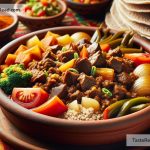How the Ethiopian Injera Became the Heart of Ethiopian Cuisine
In the rich tapestry of global cuisines, each culture brings its unique flavor, tradition, and soul to the table, creating an endless array of culinary delights. Among these, Ethiopian cuisine stands out with its vibrant spices, varied dishes, and a distinctive element that is not just food but a utensil as well – the Injera. This spongy, slightly sour flatbread made from teff flour is more than just a staple in Ethiopian meals; it’s the heart of Ethiopian cuisine. In this journey, we explore how Injera became so central to Ethiopian dining and culture.
Injera is not just another bread; it reflects the Ethiopian way of life. Made from teff, a super grain that’s packed with nutrients, it’s a testament to Ethiopia’s rich agricultural heritage. Teff grows abundantly in Ethiopia, making it a readily available ingredient for this essential food item. The process of making Injera involves fermenting teff flour with water for a few days, then cooking it like a large pancake on a clay plate called a ‘mitad.’ This process gives Injera its distinctive bubbly texture and tangy taste, which perfectly complements the spicy stews (wats) it’s often served with.
But Injera is more than its taste and nutritional value. It represents a communal dining experience deeply ingrained in Ethiopian culture. Traditionally, meals are served on a large platter with a vast Injera laid out and various stews, vegetables, and salads placed on top. Families and friends gather around the platter, tearing off pieces of Injera and using it to scoop up the accompaniments. This way of eating emphasizes sharing and togetherness, reflecting the strong communal bonds in Ethiopian society.
Injera’s significance extends beyond its role on the dinner table. Its preparation and consumption are entwined with Ethiopian rituals and traditions. For instance, making Injera is considered an art passed down from generation to generation, often seen as a rite of passage for many Ethiopian girls. Additionally, Injera plays a vital role in various Ethiopian ceremonies, including religious festivals and weddings, highlighting its importance in Ethiopian culture.
Moreover, Injera has experienced a rise in popularity beyond Ethiopia’s borders, mirroring the global interest in Ethiopian cuisine. As people around the world become more adventurous with their food choices, they’re discovering the unique flavors and communal eating experience that Injera offers. Its gluten-free nature also makes it an attractive alternative for those with dietary restrictions, further broadening its appeal.
The globalization of Injera has led to increased interest in Ethiopian culture and traditions. Restaurants serving Ethiopian cuisine often use Injera not just as a food item but as an introduction to Ethiopian dining etiquette, encouraging customers to eat with their hands and share dishes with their companions. This has fostered a greater appreciation for Ethiopian traditions and the communal aspects of its cuisine.
Despite its growing popularity, the heart of Injera remains in the homes and communities throughout Ethiopia. It’s a symbol of national identity and pride, a daily reminder of the country’s rich cultural heritage and agricultural ingenuity. The meticulous process of making Injera, from harvesting teff to fermenting the batter and cooking it on a mitad, is a testament to the Ethiopian people’s resilience and dedication to preserving their culinary traditions.
Injera’s role in Ethiopian cuisine is unparalleled. It’s not just food; it’s a cultural icon that brings people together, nourishing both body and soul. Its spongy texture and sour taste complement the spicy flavors of Ethiopian dishes, creating a harmonious balance that delights the palate. More importantly, Injera symbolizes the communal spirit of Ethiopian society, where meals are a time for sharing, connection, and celebration.
As Injera continues to win hearts globally, its essence remains deeply rooted in Ethiopian culture. Whether enjoyed in a bustling restaurant in Addis Ababa or in a quaint eatery halfway across the world, Injera transcends boundaries, connecting people through the universal language of food. It’s a beautiful reminder of how a simple flatbread can become the heart of an entire cuisine, embodying the spirit of a nation and its people.
In conclusion, Injera is much more than a culinary masterpiece; it’s the soul of Ethiopian cuisine. Through its nutritious ingredients, communal eating practices, and deep cultural significance, Injera has rightly earned its place at the heart of Ethiopian dining. It’s a testament to the rich cultural tapestry of Ethiopia, inviting everyone to partake in its shared tradition of togetherness and warmth, one tear-off piece at a time.


